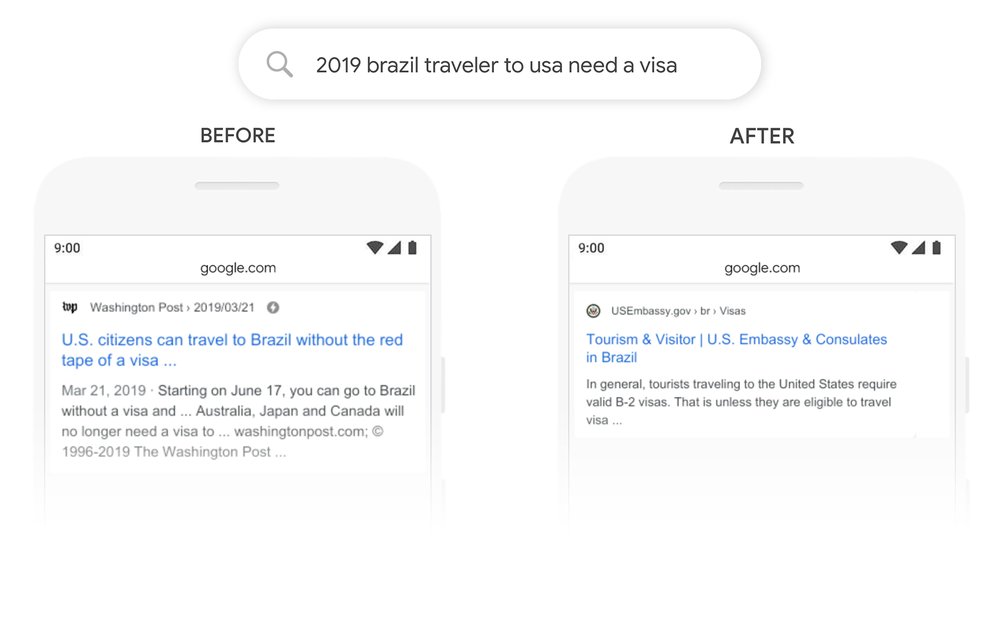SEO
You may or may not have heard, but Google has recently rolled out its biggest update in five years, and with 10% of search queries being affected, there’s a good chance your SEO efforts may need to be tweaked.
This update is called BERT. It stands for Bidrectional Encoder Representations from Transformers.
Without going deep into the technical jargon of algorithms and neural networks, we’re going to explain what this means and what can be done to keep your website ranking highly in light of this update.
What the update comes down to is Google building a better understanding of natural language processing. Natural language processing is the artificial intelligence that aims to understand human communication better.
Before the update, Google primarily assessed search queries by looking at single words. It will now look at the entire phrase. Sometimes words like for, to, in etc, can give a sentence a different meaning. This means that Google now emphasizes understanding the context of your search.
Here is an example:

Source: https://www.blog.google/products/search/search-language-understanding-bert
In the search 2019 brazil traveller to usa need visa, the word “to” makes all the difference to the search. Before BERT, the search results would target travellers from the USA to Brazil. If you look carefully, the search is actually the other way around. This is the kind of thing that BERT improves upon.
When people make searches on Google, they will generally come under one of three query types:
Informational
Navigational
Transactional
An informational search is when a user is simply searching for information. Perhaps they want to start cooking healthier meals, they might search what are the best healthy chefs. The correct answer may take them to a blog or website provides a list and information of the top healthy chefs.
The next step in this process could be a search for Tom Kerridge recipes. This is a Navigational search. The user knows what they’re looking for here and the search has more focus.
A further search here could be Tom Kerridge healthy book. This is a Transactional search where the user has a clear intent to make a purchase.
The BERT update focusses mainly on the informational keywords and phrases so that people get answers to their questions quicker and more efficiently.
How can I keep my website ranking up?
Well, the short answer to this is to get specific with your content. Answer people’s questions.
In your SEO research, start focussing more on long-tail phrases as well as just words, and start developing very specific content around a topic, rather than one huge page that covers a range of topics and has an endless word count.
It’s about quality over quantity.
Don’t worry too much
Although the BERT update is a big one, it won’t start penalising you for any new reasons, it’s purpose is purely to better understand what people are searching for and why. It wants content that answers questions.
If you have noticed a drop in your traffic recently or would like to get a more in-depth look at your domain and keyword ranking, then LimeGreen Marketing can develop a report that looks into this and can offer up and carry out required tweaks. Get in touch with us today to find out more.
The prospect of a new website can seem both exciting and incredibly daunting at the same time. Every company will have different requirements and limitations according to the size of their organisation, resources available, budget, professional know-how and much more.
At LimeGreen, we understand that sometimes it’s useful to have a helping hand and a few pointers to help you make the first step in the right direction. That’s why we’ve put together these seven steps to take the worry out of your new website!
1. Why do you need a new website?
This might seem like a stupid question but it really is the first thing to consider. Is the new website a design-led decision in line with a company rebrand or are your requirements more practical? Often businesses can outgrow their original website but before dreaming up a new one, it’s important to ensure that this time it can grow with your business. This could save money in the future.
2. Choosing a domain and hosting
In order for any website to work, you’ll need a domain and hosting. Think of your website domain as the address for your website. This is what people will type into their web browser to reach it, e.g. www.limegreenmarketing.co.uk.
Hosting is where on the internet your website physically is or, the plot of land where it lives if you will! It’s important that you choose the right domain and hosting to suit your requirements. For more information, take a look at our article ‘What is Hosting?’.
3. Design
An all singing, all dancing website sounds like it could be pretty impressive. If you have a concept that you want to use that reflects your brands ethos digitally then go for it! Online branding should always be consistent with offline branding. However, your design should never compromise your product or service or your ability to communicate clearly what it does.
4. Functionality
Think about who uses your website and why? Are they looking for information? Are they looking to purchase a product or service? Is your website user-friendly? There is no point in having a website where people can’t find what they’re looking for.
Be sure to think long and hard about menus and site navigation. Equally a straightforward search feature and cataloguing or tag system for organising products could make life much easier for you and your customers. Remember, if someone can’t use your website, they’re more likely to go to a competitor.
5. SEO and Analytics
So, you’ve got your new website up and running with a domain, hosting and functional, on-brand design. That’s it right? Wrong! It’s important to make sure that your website is Search Engine Optimised. Doing this makes it easier for popular search engines to read your site and determine its content and where it should appear in individual search results. There are lots of handy plugins that you or your web developer can use to help with the process. We work with WordPress sites a lot and recommend Yoast (read more here).
In addition to SEO optimisation tools, updating your websites content regularly can help improve its rankings with popular search engines. Including a blog and regularly posting new articles is one way to do this. Including social media streams from Twitter and Facebook on your website can also help.
Equally it’s important not to neglect your analytics. These will tell you who is viewing your website, how long they are spending on your website and where this traffic is coming from. Valuable information that shouldn’t be wasted!
6. CMS and CTAs?!?
There’s a lot more to your website than meets the eye. You’ll need a functional program taking care of the backend – a Content Management System – CMS. This is what organises your content and makes sure everything is where it should be. Your website visitor can’t see it but, trust us, they’d soon know about it if it wasn’t doing its job!
Call to Actions – CTAs – also play an integral part in your website. These are prompts on pages strategically placed to encourage the website visitor to complete an action, e.g. call us, book online, get in touch, buy now. These are designed to entice the website user to behave in a way that will benefit your business. Don’t forget to consider them in your design.
7. Maintenance
It’s a great feeling once you’ve got your brand spanking new website up and running but what happens going forward? It’s likely that you’ll need to make changes to pages over time or update products, company information and events, and it’s important that you can do this quickly and easily so that your clients or customers have the most up to date and relevant information. While some larger organisations may have the luxury of a dedicated in-house web team to do this, smaller organisations may need to outsource this work. So, it’s worth factoring this into your budget.
If you’d like to speak to one of our team about your own website, you can get in touch by emailing info@limegreenmarketing.co.uk. Alternatively, pick up the phone and call us on 01600 891525 – we’d love to hear from you!

